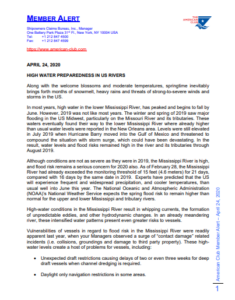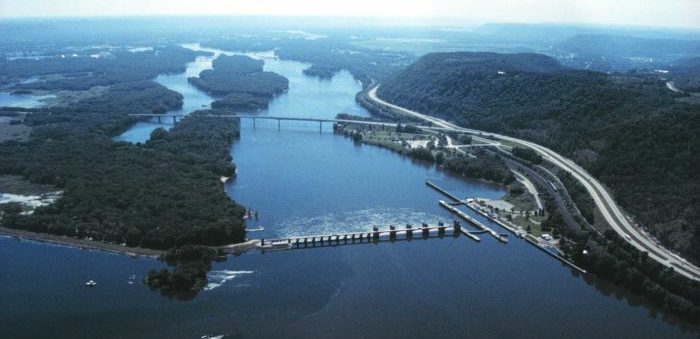The year 2019 was a rough year for safe navigation in Mississippi River, with major flooding in the US Midwest. This flood risk remains a serious concern for 2020 also, as the Mississippi River had already exceeded the monitoring threshold of 15 feet by late February 2020.
Although high water in the lower Mississippi River normally begins to fall by June, high levels continued in July 2019 when Hurricane Barry moved into the Gulf of Mexico. As such, water levels and flood risks remained high in the river and its tributaries through August 2019.
Although conditions are not as severe as they were in 2019, the Mississippi River is high, and flood risk remains a serious concern for 2020.
As of February 28, the Mississippi River had already exceeded the monitoring threshold of 15 feet (4.6 meters) for 21 days, compared with 16 days by the same date in 2019. Experts have predicted that the US will experience frequent and widespread precipitation, and cooler temperatures, than usual well into June this year,
…the American P&I Club warned in a new member alert.
These highwater levels create a host of problems for vessels, including:
- Unexpected draft restrictions causing delays of two or even three weeks for deep draft vessels when channel dredging is required.
- Daylight only navigation restrictions in some areas.
- Damage to anchor windlasses or loss of anchors, which often “dig” deep into the soft mud as vessels are impacted by the strong current.
- Standby tugs and 24-hour on-board pilotage at certain berths and midstream buoy facilities
Meanwhile, NOAA’s National Weather Service expects the spring flood risk to remain higher than normal for the upper and lower Mississippi and tributary rivers.
Recommendations
With respect to the above, USCG Captain of the Port of New Orleans expects vessels, facilities, and vessel agents planning a vessel movement of any sort, to consult with the appropriate pilot associations to determine whether a pilot and/or tugs are necessary for the intended shift.
In addition, the American Club advises ship managers to:
- Consult the US Coast Guard, class, manufacturer or internal company policies to determine a suitable towing vessel horsepower to barge tonnage ratio, considering weather conditions, currents and other maneuverability factors, if and as necessary.
- Utilize a vetted and experienced captain and consider their mental and physical fatigue prior to the voyage.
- Take all proper precautions to best anticipate river conditions, weather, the area of transit, and the pilot’s level of comfort when arranging the number of barges in tow.
- Report and share up-to-date information with the company or industry safety associations regarding any observed collisions, allisions, near misses, or navigation troubles in frequently transited areas to generate awareness and establish best practices.
- Pay extra attention to traffic in the area and use all available means of navigational information available, i.e. VHF radios, radar, AIS, and VTS as applicable.
- Avoid all unnecessary distractions like cell phones calls and texts to the captain or pilot on duty.
- Discuss the prevailing conditions with the river pilot prior to commencing the shifting and carefully monitor the vessel’s movement during the transit.
- Review procedures for anchoring and monitoring anchor position and pay particular attention to the condition and maintenance of anchoring equipment.
Find more resources with additional information on the subject herebelow:

See also:
Potential hazards when anchoring and mooring in Mississippi river






























































